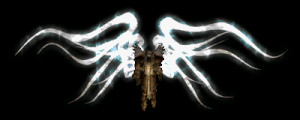
Tyrael, the Archangel of Justice
The world of Sanctuary is home to a variety of faiths and religions. Some are various interpretations of a single philosophy, while others subscribe to their own pantheon of gods and goddesses.
Origins[]
Anu is the first being of existence and the origin of pure good. The dark being of Tathamet, a seven headed dragon, was created when Anu shed all evil from his form which later manifested into being. It is said that the world began when these beings destroyed each other after a great battle. The Worldstone is thought to be Anu's eye, while the Crystal Arch seems to be his spine and the foundation of the High Heavens. The five archangels of the Angiris Council were created out of Anu's five virtues, while the Great Evils were spawned from Tathamet's seven heads.
Religions of Light[]
The most common religious philosophy among men is that of the Light, a reverence for the primal force of justice and goodness in the world. The angels of the High Heavens are the foremost powers regarding the Light, and dedicate their existence to fighting evil, primarily that of the Burning Hells.
Skatsim[]
Known as the "Old Religion", Skatsim was the most common faith of The Light in Kehjistan before the rise of Zakarum. Few adhere to Skatsim any more, though the Taan Mage Clan (of which Ormus is the only known member) is well versed in Skatsimi magic, which was used to protect the docks of Kurast from the forces of Mephisto in 1264.
Cathedral of Light[]
Founded in direct opposition to the Triune, the Cathedral of Light was created by Inarius, a renegade angel who disguised himself as a man named The Veiled Prophet. Both faiths founded their temple in the city of Kehjan. The highest rank of the church was the Procurator General, with the rank of Master Inquisitor being the middle priest rank. Inquisitors acted as the basic infantry of the church.
Zakarum[]
Many ages ago, a man name Akarat believed he was visited by the Archangel Yaerius, who instructed him to found a new faith of The Light. Although Akarat began his teaching in the west, it is in the east where his teachings became the most widely followed. The holy city of Travincal was founded in Kurast, and it became the residence of the High Council of Zakarum.
The Zakarum faith is very structured and has a complex hierarchy, with the Que-Hegan acting as the highest church official and leader of the High Council. The next named rank of the church is archbishop, with Archbishop Lazarus being the only named member of this rank. Other ranks of priests are Heirophant, Cantor and Sexton. It can be assumed that members of the High Council hold these priestly titles, though it is possible that Council Member is a rank in of itself, only second to the Que-Hegan.
Throughout its history, Zakarum has maintained a powerful standing army called the Hand of Zakarum to protect its adherents from demonic corruption. Members of the order are paladins, divine knights entrusted with holy powers to further the goals of The Light. The base rank is Zakarumite, with Faithful and Zealot being the titles for more experienced members.
Sometime before the events of Diablo I, Mephisto began to corrupt the High Council until it was completely under his control. On his way to defeat Mephisto, the hero of Diablo II must confront legions of Zakarumites who have been convinced that the world has fallen to evil, and that all of its corrupt people must be destroyed, when it is in fact them who have fallen to the dark.
During the events of Diablo III, a man named Brother Malachi the Healer is seen in New Tristram claiming that the Zakarum faith has fallen from sanctity, showing that Zakarum is either still corrupted by darkness, or that the damage inflicted upon the church was enough to make it collapse after the demonic corrupters were defeated.
Knights of Westmarch[]
Many Zakarumites were displeased with the levels of fanaticism and brutality exhibited by their brothers in arms against those who did not worship the "correct" way, and so they left to form a new knightly order. The Knights of Westmarch were founded to focus their efforts on combating demonic darkness. They fought and defeated the army of Khanduras under the command of King Leoric during the events of Diablo I.
Religions of Darkness[]
Due to the nature of their faith, followers of darkness do not belong into any large, organized institutions. Rather, the followers of demonic teachings usually join small cults or covens led by some sort of dark mage, lesser demon or corrupted priest and practice their profane rituals in secret. The Dark Cultists spend much of their worship summoning demons from hell and raising undead for their own ends, particularly Dark Hellions. Some cultists turn themselves into Dark Vessels, carrying the spirit of a demon inside them. When the time is right, they allow the demon to take over their bodies, and they become a Dark Thrall. During times of high demon activity on Sanctuary, cultist numbers swell and people become much more aware of their presence.
The Triune[]
Early on in the world of Sanctuary, the Prime Evils attempted a discrete approach of converting the populace to their demonic ways. By adopting alter egos, the demons were able to gain followers under the guise of a religion of Light they named the Triune. It was led by a high priest called the Primus, with two lieutenant High Priests as his seconds in command. The Peace Warders were the uniformed priests and soldiers of the church. Members of the Cathedral of Light brought an end to the Triune, but some followers considered to worship in secret, even in the days of Diablo III.
Khazra Traditions[]
The Khazra are savage goatmen who inhabit the wilds of Sanctuary. They were once men, though dark magics twisted their form until they became what they currently are. The Khazra worship the dark powers of the Burning Hells, and evil altars are a common sight around their settlements. Many Khazra reside in the Burning Hells itself, and most settlements have the means to open portals that summon their brethren back to Sanctuary when their settlements are in danger.
Other Religions[]
The Priests of Rathma[]
Also known as the Necromancers, the Priests of Rathma dedicate themselves to a notion called the Great Cycle of Being, a philosophy that places balance above all else. The priests practice their faith in the swamplands of the far east.
Rathma was a Nephalem who encountered Trag'Oul, a great dragon that was the guardian of Sanctuary. He was instructed by Trag'Oul in the ways of balance, and his first disciple, Mendeln, was taught how to speak to the dead. They learned how the greatest balance of all was between life and death, darkness and light, and thus necromancy became a central tenet of the priests' faith.
The Sisterhood of the Sightless Eye[]
The Sisterhood is located between Khandaras and Aranoch, operating out of a large monastery. They are descendent from the Amazons of the Skovos Isles and place a high regard on the spiritual awareness of Inner Sight. They consider themselves allies of heaven and goodness. The Rogues are the warriors of this order, and they are led by a priestess. Akara holds this title during the events if Diablo II.
The Pantheon of the Askari[]
The Skovos Isles are home to the Askari people, notable for their order of women warriors called Amazons They follow a polytheistic religion that holds order in the highest regard. Athulua is their prime deity, who rules over the weather and seasons with her consort Kethryes. Under these goddesses are various other deities, such as Karcheus, Zerae and Hefaetrus, each responsible for a facet of Amazon life. The Amazons believe that they will play some great role in defeating the Prime Evils of the Burning Hells.
Nephalemic Worship[]
The Barbarians of Mt. Arreat revere the "Ancients ", the spirits of three legendary warriors chosen to protect the Worldstone located within mountain. Their names are Korlic, Madawc and Talic and the three are in fact Nephalem. The spirits wield considerable power, enough to destroy most things that would threaten the Worldstone. It is unclear what happened to them after the destruction of the Worldstone.
Mbwiru Eirkura[]
Roughly translated as "The Unformed Land", this is the faith of the Umbaru people of the Torajan jungles. This philosophy states that sacred reality, the realm of the gods, is hidden behind the physical world, and that mana is the essence of the gods that seeps into the physical realm. In order to ensure this all-important life energy continues to flow into the world, the Umbaru believe they must partake in ritual human sacrifice.
Giyua is a mythological figure who is said to be the guardian of the Unformed Land and greets mortal souls of the deceased upon their arrival.
Witch Doctors are the spiritual leaders of Umbaru tribes and administer all magic rituals and spiritual activities in the tribe. The faith of the Umbaru stresses non-individuality and sacrifice for the greater good.
Shaptev[]
The Monks of the monastic city of Ivgorod are an intensely spiritual people that believe divinity manifests itself everything, from elements and seasons to behaviors and actions. They refer to this aspect of infinite divinity as the 1001 gods. They strive for perfect internal balance, and align themselves with the forces of good.
One of the gods is Ytar, whose name is exclaimed when a monk executes a particularly powerful attack. Ytar may be the god of war or anger, and may be the patron god of the order. Inna is known as the goddess of the sky, known for her immense beauty. The monk character and the Templar sometimes argue about the sense behind having 1001 gods.
The 59 Gods of Xiansai[]
The people of the island of Xiansai revere a number of gods that total 59. The most well known, if not revered is Zei, the god of thieves. It is said that he often disguises himself as a mortal and searches the world for rare jewels.
Nature Worship[]
The druids of Scosglen worship the four primal energies of the world - fire, earth, air and water - as well as the various nature spirits of plants and animals. The druids shun the traditional use of magic that uses mana or "Dubhdroiacht" as they call it, in order to maintain a closer bond with the powers of nature they revere.
Vecin Religion[]
The Vecin travelers of Kehjistan put their faith behind the Allmother, the patron deity of the matriarchal society. They believe that the Allmother gifts some followers with The Sight, a "sixth sense" that manifests itself more strongly in women. It is possible that this power is related to the Inner Sight wielded by the Sisterhood of the Sightless Eye.
| |||||||||||||||||||||||
